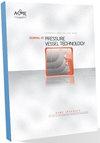Fatigue Crack Growth Evaluation Of Pipeline Steels And Girth Welds
IF 1.4
4区 工程技术
Q4 ENGINEERING, MECHANICAL
Journal of Pressure Vessel Technology-Transactions of the Asme
Pub Date : 2023-08-30
DOI:10.1115/1.4063293
引用次数: 0
Abstract
Fatigue test specimens were prepared and tested with an API 5L X70 spiral welded pipe steel and girth weld. For a few selected specimens, two unloading compliance techniques (elastic compliance and back-face strain compliance) were applied simultaneously to a single specimen for direct comparisons of in-situ crack size estimation. This paper also includes fatigue crack growth rate (FCGR) data of other pipe steels and welds available in the literature. It was observed that most FCGR curves of pipeline steels (X65~X100) remained within the BS 7910 mean and upper bound design curves in the Paris region. On the contrary, the fatigue crack growth rate of the X42 pipeline steel from a reference was high - a very steep slope of the FCGR curve, crossing over the BS 7910 design criteria. It was noted that the FCGR of austenitic stainless pipe steel and girth weld obtained from Arora et al. (2014) showed a very excellent fatigue property.管道钢和环焊缝疲劳裂纹扩展评价
用API 5L X70螺旋焊接管钢和环焊缝制备并测试疲劳试样。对于少数选定的试样,将两种卸载顺应性技术(弹性顺应性和背面应变顺应性)同时应用于单个试样,以直接比较原位裂纹尺寸估计。本文还包括文献中其他管道钢和焊缝的疲劳裂纹扩展速率(FCGR)数据。在巴黎地区,管线钢(X65~X100)的FCGR曲线大多保持在BS 7910的平均值和上限设计曲线范围内。相反,参考资料中X42管线钢的疲劳裂纹扩展率很高——FCGR曲线的斜率非常陡,超过了BS 7910设计标准。值得注意的是,从Arora等人(2014)获得的奥氏体不锈钢管和环焊缝的FCGR显示出非常优异的疲劳性能。
本文章由计算机程序翻译,如有差异,请以英文原文为准。
求助全文
约1分钟内获得全文
求助全文
来源期刊
CiteScore
2.10
自引率
10.00%
发文量
77
审稿时长
4.2 months
期刊介绍:
The Journal of Pressure Vessel Technology is the premier publication for the highest-quality research and interpretive reports on the design, analysis, materials, fabrication, construction, inspection, operation, and failure prevention of pressure vessels, piping, pipelines, power and heating boilers, heat exchangers, reaction vessels, pumps, valves, and other pressure and temperature-bearing components, as well as the nondestructive evaluation of critical components in mechanical engineering applications. Not only does the Journal cover all topics dealing with the design and analysis of pressure vessels, piping, and components, but it also contains discussions of their related codes and standards.
Applicable pressure technology areas of interest include: Dynamic and seismic analysis; Equipment qualification; Fabrication; Welding processes and integrity; Operation of vessels and piping; Fatigue and fracture prediction; Finite and boundary element methods; Fluid-structure interaction; High pressure engineering; Elevated temperature analysis and design; Inelastic analysis; Life extension; Lifeline earthquake engineering; PVP materials and their property databases; NDE; safety and reliability; Verification and qualification of software.

 求助内容:
求助内容: 应助结果提醒方式:
应助结果提醒方式:


